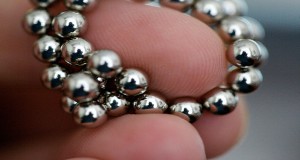
October 22, 2013
Pediatricians and Consumer Advocates Ask CPSC for Swift Action on High-Powered Magnet Safety Standards
WASHINGTON, D.C. – Today at a public hearing on high powered magnets held by the U.S. Consumer Product Safety Commission (CPSC), pediatric gastroenterologists and consumer advocates asked for swift regulatory action that would ban the sale of high–powered magnets and stop new novelty high–powered magnet products from ever reaching the market, emphasizing that strong regulations are the only effective way to prevent children from accidentally ingesting super strong, rare earth (or Neodymium) magnets.
In September 2012, the CPSC issued a notice of proposed rulemaking which would prohibit the sale of high–powered magnet sets (defined as aggregations of separable, permanent, magnetic objects intended or marketed by the manufacturer primarily as a manipulative or construction desk toy for general entertainment) if the magnet set contains a magnet that fits within the CPSC’s small parts cylinder and has a flux index (or strength) of more than 50. The CPSC took this action in response to a growing number of documented pediatric ingestions of magnets from magnet sets.
High–powered magnet sets, marketed under names such as Buckyballs and Zen Magnets, are comprised of tiny high-powered magnet balls or cubes, often with 200 or more magnets to a set. When more than two magnets are swallowed, their attractive force (flux) allows them to find each other across or between different segments of the bowel. For example, connections can occur between the stomach and the small intestine, between the small intestine and the colon, or across loops of bowel. When this happens, the result can bowel perforation, fistulization (unnatural connections of the bowel), or tissue death (necrosis).
The danger of these high-powered magnets are complicated by the difficultly of a timely diagnosis. Ingestion of magnets does not result in immediate symptoms; consequently, there can be marked delay in diagnosis and treatment, particularly when ingestion occurs in a toddler or child with a developmental or psychiatric disorder who cannot verbalize the ingestion. Yet, injury following ingestion can begin tooccur in as little as eight hours. When symptoms do occur, they are non-specific (abdominal pain, fever, vomiting) and may resemble other common ailments.
High–powered magnets are not like other small foreign objects that children typically swallow. According to a 2012 study by the North American Society for Pediatric Gastroenterology, Hepatology and Nutrition (NASPGHAN), nearly 80 percent of high–powered magnet ingestions cases require endoscopic and/or surgical intervention. Comparatively, only 10 to 20 percent of other foreign body ingestions require endoscopic removal and less than 1 percent require surgery.
“CFA strongly supports CPSC’s determination that there is an unreasonable risk of injury associated with children ingesting high powered magnets,” stated Rachel Weintraub, Legislative Director and Senior Counsel at Consumer Federation of America. “Data from CPSC and from pediatric gastroenterologists across the country documents the serious medical consequences that occur as a result of a child ingesting more than one high powered magnet. The unique properties of these magnets compel a regulatory solution such as the one CPSC has proposed, that would protect children from the severe consequences of ingesting more than one of these magnets.”
“Actions taken to date by the Commission appropriately reflect the risk of significant and life-threatening injury that these magnet products pose to children,” said Athos Bousvaros, M.D., NASPGHAN president. “There is nothing worse as a physician than treating a child with a preventable injury. High-powered magnet ingestions are 100 percent avoidable if they are not available, which means banning their sale and doing everything possible to remove products already sold from any environment where children live, visit, play or learn.”
“When a child swallows a small coin or marble, it may pass without incident. But when two or more high-powered rare earth magnets are swallowed, the force of magnetic attraction is so strong that parts of the gastrointestinal tract may be pulled together. This can lead to severe infections, permanent injury, or even death,” said Ami Gadhia, senior policy counsel for Consumers Union. “Parents and caregivers may not appreciate the unique harm caused by the strength of these magnets. This is why the CPSC’s proposal to eliminate the hazard posed by high-powered magnet sets is critical to protecting children while they play.”
“As pediatricians, our number one goal is to keep children safe,” said AAP President Thomas K. McInerny, MD, FAAP. “The powerful, tiny magnets contained in these products have caused unnecessary surgeries and debilitating injuries in infants, children and adolescents. Pediatricians have been ringing an alarm bell about these dangerous magnets since we first recognized the damage they cause, and we welcome the Consumer Product Safety Commission’s proposed rule as a needed step forward to protect children’s health and safety.”
###
The American Academy of Pediatrics is an organization of 60,000 primary care pediatricians, pediatric medical subspecialists and pediatric surgical specialists dedicated to the health, safety and well-being of infants, children, adolescents and young adults. For more information, visit www.aap.org.
The Consumer Federation of America is a nonprofit association of nearly 300 consumer groups that, since 1968, has sought to advance the consumer interest through research, advocacy, and education. www.consumerfed.org
Consumers Union is the public policy and advocacy division of Consumer Reports. Consumers Union works for telecommunications reform, health reform, food and product safety, financial reform, and other consumer issues. Consumer Reports is the world’s largest independent product-testing organization. Using its more than 50 labs, auto test center, and survey research center, the nonprofit rates thousands of products and services annually. Founded in 1936, Consumer Reports has over 8 million subscribers to its magazine, website, and other publications.
Incorporated in 1972, the North American Society for Pediatric Gastroenterology, Hepatology and Nutrition, with more than 1900 members, is the leading society in the field of pediatric digestive diseases. www.naspghan.org
CONTACTS:
North American Society for Pediatric Gastroenterology, Hepatology and Nutrition, Camille Bonta: (202) 320-3548
Consumer Federation of America, Rachel Weintraub: (202) 387- 6121
Consumers Union, Kara Kelber: (202) 462-6262
American Academy of Pediatrics, Jamie Poslosky: (202) 347-8600
